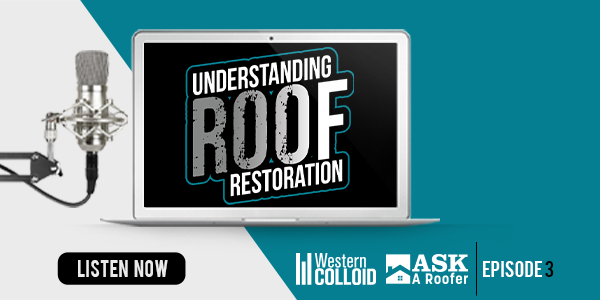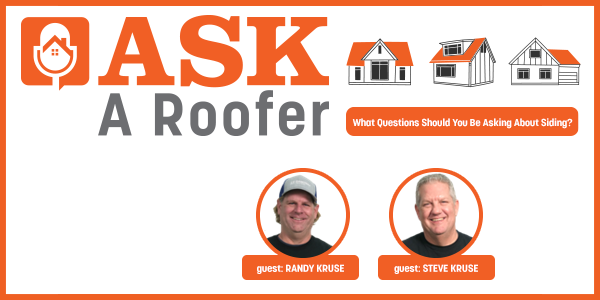Understanding Roof Restoration Episode 3 - How to Deal With Roof Deck Damage

Editor's note: The following is the transcript of a live interview with Greg Hlavaty and Hal Leland of Western Colloid. You can read the interview below, listen to the podcast, or watch the webinar.
Karen Edwards:
Hello, and welcome to the Understanding Roof Restoration Podcast. I'm your host, Karen Edwards, from askaroofer.com. The Understanding Roof Restoration Podcast dives deep into the topic of restoring roofs. As the popularity of roof restoration continues to grow among building owners and contractors, there are many questions that arise. With a wide variety of roofing systems on existing buildings and many available restoration options, we turn to the experts at Western Colloid to answer your questions on roof restoration. Greg Hlavaty, Hal Leland, and the team at Western Colloid have been manufacturing and installing these systems for more than 50 years, and they have seen it all. We will tackle a different topic each month and answer questions submitted by you, our listeners.
Hello everyone, and welcome back to the Understanding Roof Restoration Podcast. I'm your host, Karen Edwards, with AskARoofer. And I'd like to welcome back Greg Hlavaty and Hal Leland from Western Colloid. Welcome back.
Greg Hlavaty:
Good to be here, thanks.
Karen Edwards:
Excellent. So I'm really excited about today's topic, and we're going to look at what do you do about damaged roof decks when you want to install a fluid applied roof system, but you're not tearing off the roof. And I often wonder, there's a roof on there, how do you even find out that the deck is in good condition or not? What do you need to do?
Greg Hlavaty:
Well, there's several ways, and this has become more of a hot topic because there are more renovations going over roofs without tearing them off. I can remember in the past many consultants said, "If I can't see the deck, I won't write a spec." They always wanted everything torn off and everything, but that became wasteful. But there are definitely ways to find out if you have problems.
The first way, out here in the West at least, we have mostly plywood decks, wood decks, and those become soft and spongy. When you walk a roof, when you're doing your roof evaluation and you walk it, you can see the roof deflections and ponding areas, and you can see if the deck is soft underneath. It's a little different on concrete decks and metal decks that you find in the Midwest and the East, but most of our decks out here in the West are plywood. And there are ways of, if you can get interior access depending on the type of building, so you can get underneath and take a look if they've had leaks. Usually, you can pinpoint to where the leaks have been, because that's where the damage is going to be. So if they've had leaks, you already got it isolated to a certain area.
Karen Edwards:
Yeah, Hal, I'd love to hear what your experience is here.
Hal Leland:
Well, working with the specifiers and the consultants, most of those guys want to either fly a drone over or do some pinpoint moisture testing, and we like that. But Greg's right that most of the decks out West are wood decks, and we can isolate areas around drains, penetrations, these sort of things are normally the spots where we're going to have these types of problems. And we're always going to open those areas up on whatever kind of membrane is there and replace those areas, take a look at the wood around those areas. And normally it's five or six squares out of a 200 square project, a 500 square project. It's not a large area. And we'll replace the wood deck, we'll replace the roofing with like materials, and then we'll go ahead and put one of our assemblies down over the top of the whole thing.
So it's normally pretty simple. If the entire deck is sponged out and this thing's been sitting there for 30 years soaking up water, it's not going to be a candidate. We will have to tear it off and we'll have to put something else on. We can't fix every roof, but 90% of them, we can.
Greg Hlavaty:
Right. That's important to say, that you can do a lot with a roof renovation system, but you can't do everything. So there are times when a roof needs to be removed, but there are many times when a roof is removed when it didn't need to be. In most cases, it can be isolated. The different types of decking can be replaced. Sometimes they'll put in, if it's got insulation down or something that is holding water, that can be replaced. Or in certain types of insulation, you can put vapor relief vents into that roof that allows it to dry out.
Again, here in the West where we have wood decks, they tend to dry out over the period of the summer, because there's a lot of air movement and moisture that is drawn away through the wood and evaporated through the structure and what have you. So they'll dry out, where a metal deck or a concrete deck, like you find many more of in the Midwest and the East, can tend to hold moisture below the membrane. And that's where especially the moisture scans come in.
And then you can do core cuts to get down in certain areas without tearing off too much of the roof. You can do isolated core cuts around suspected problem areas. Once you do a core cut, then you can evaluate down to the deck.
And then it's a matter, like Hal said, of opening it up. A good contractor can open up that area. If there's two or three squares of soft deck that needs to be replaced, he might open up four or five around it to make sure everything's open, replace the deck with the decking material, and then go back with a like membrane. If it's a commercial built up granulated surface, they might go back with a modified bitumen, something that they can get down and tie that roof off, make it watertight with the replacement roof, and then doubly watertight when the new fluid applied membrane goes over it, over the whole system.
Hal Leland:
We'll make that deck waterproof before we put our assembly on. So if we're going to repair an area, we put that like material, the peel-and-stick, whatever it is, down, and now we have a watertight deck again, and it looks like it would've been before we came up there. Then we put our assembly down.
Karen Edwards:
Okay. You make it sound so easy, but I'm sure it's much more involved than that. I would be nervous as a contractor, making sure that I got the entire area. And I think, Greg, you mentioned, if it's two or three squares, maybe you take out four to five squares around it to ensure that you got it all. Are you available to help contractors determine that, whether one, is the roof a candidate, and two, if so, helping them ensure that they did identify the entire problem area?
Greg Hlavaty:
Sure, that's a big part of what our people do. Almost every day, we're walking roofs in our region that we sell. Our people are out with contractors, with consultants, building owners, walking their roofs, looking to see if it's a candidate. Like any good manufacturer, some are and some aren't, we're honest, we're not just trying to just sell our system, we're trying to make sure they get something that's right for them, that they're doing the right thing.
And so we evaluate. We use a service, give them a free plug, the CompanyCam, which is a service where you upload all your photos to the cloud and then everybody on the team can see them. Every morning when I get up, I pop open my CompanyCam page and I see roofs in Texas being walked, and New Mexico, and Arizona, California. And all of us take a look at it, and it isn't just that person evaluated. It's Hal looking at it. I'll catch something on there and say, "Hey, did you see that drain is too high? It's going to be hold water there."
So there's more than just that one person walking that roof. All of us are looking at the photos and the videos, descriptions of the roofs, to make sure we give them the best option for their building.
Karen Edwards:
Wow. Isn't technology wonderful?
Greg Hlavaty:
Yep.
Karen Edwards:
It allows you to be on that roof with a contractor and give them the confidence then that they have other experts sharing their opinion.
I'm curious, how often do you find roofs with damaged decking that needs to be addressed when somebody wants to do the fluid applied restoration?
Hal Leland:
Oh, it's not every time. If I had to put a percentage on it, I'd say 25% of the time there's going to be some work on the deck. And normally, like I said before, that's right at drains, the most difficult spot, and where all the water's going down and where it's got all that flow for 20 years. It's worn the granules away. It's constant intrusion of water.
It's normally not that bad. Like Greg said, a couple squares of plywood, four or five sheets of plywood. And even if you have a little bit of moisture left down inside that deck, it's not the end of the world, because there is air movement in there, and we're going to make it watertight and you're never going to see water going down into it again. So yeah, it happens. It's not a big deal for us.
Greg Hlavaty:
And with insulation, there's different types of insulation, too. That's another factor, is some of the insulation that was used in the past, still used some, but the perlite insulation, that was used very wide heavily in the '70s, '80s, '90s. They still do some of that but not as much because it doesn't have the high insulation value. But that holds water. So if you got that, you know that's going to soak it up and it won't release it.
So different types of insulation, where urethane, ISO insulation, and the plastic insulations, those don't hold as much water. If you let them dry out, they're good and dry. So a lot of the judgment is what type of insulation you find if you do a core cut, whether it's going to hold water.
And a lot of it is dependent on the area, like Hal said. Hal works more in Northern California and the Pacific Rim where they get a lot of rain. And I'm more in here in Southern California and in Arizona, and probably maybe 10% of the decks, maybe because even if they do leak, they dry out fast, as opposed to laying there wet for a long period of time, which is when the dry rot can happen and the deck deterioration.
So some of it is, your judgment is made on the type of area you're in. There isn't a lot of decks replaced over in Arizona because yeah, they'll get some heavy rains, they'll get leaks, and boom, and then it's dry in a week, and dry for the rest of the year. So they don't get the deterioration. But the coastal areas here in California, they're more prone to that, so you have to be sensitive.
And that's part of working with a quality contractor knows, that has some experience, kind of knows what they're looking for. And if they don't, we're there to help the new ones. But that's a big part of it, is getting a contractor that's comfortable looking at a roof and evaluating it. A roof isn't just what you see on the surface. There's so much more to it, a lot of things. And that's what a good quality roofer learns over the years.
Karen Edwards:
This podcast is brought to you by AskARoofer and Western Colloid Fluid Applied Roofing. When you're looking for answers for your roof, what better place than askaroofer.com. If you are looking for answers on restoring your commercial, industrial, or low slope roof, look no further than Western Colloid. For over 50 years, they have been bringing old roofs new life. Together, we're helping contractors, building owners, property managers, architects, engineers, and consultants choose the best commercial roofing system. Find Western Colloid today on askaroofer.com.
So we talked about, you see in the western part of the United States, more plywood, wood decks. Do you ever see metal decking that needs to be repaired prior to an installation?
Greg Hlavaty:
It isn't as common here. They do get leaks and they do have issues. But when you have a deck, a metal deck, that is already treated to withstand moisture over the years, galvanized or some other zinc or other treatments to make those decks impervious, if they have metal deck corrosion and rot, then it's pretty serious. They've had a serious leak for a long time.
In the West, you don't see as much metal deck replacements because it does dry out fast enough. Again, Midwest and the East where they can insulation, hold the water, and months at a time that deck is wet, they get more corrosion and rust, and where they might have to replace it. But not a lot of metal decks get replaced here in the West. Wouldn't you agree, Hal?
Hal Leland:
Well, I've got a group of tilt-ups in South Bay, in Northern California, that around areas of drains, again, they have metal decks, and these are really built up, heavy gauge metal decks. And last year, I've had to replace metal areas around drains on three of these tilt-ups, and these are thousand square buildings. And it was about 10 by 15 foot areas around a drain, super heavy gauge metal, and we had the contractor hire a metal guy to come out. These areas weren't safe, but the rest of the roof was completely perfect. So he replaced metal, welded new metal panels in, didn't cost a lot of money, and we saved those thousand square roofs, and everyone's happy at the end of the day. So yeah, it does happen in wetter areas.
Greg Hlavaty:
I was going to say, that's Bay Area, and the Bay Area, it mimics other areas of the country that stay wet longer period of time, where we're getting rain right here in Southern California, and next week, or in a day or two, guys will be roofing and it'll be dry, where other areas, it stays gray, and dark, and cold. They don't dry out fast and then that's when the corrosion and deterioration happens, so.
Karen Edwards:
Do you ever have concerns from the building's owner about, "Oh, well, if there's a problem on the deck," or Hal, are they worried that maybe it all needs to be redone? Or are you pretty much able to say, "Hey, we've got all these examples of it that it works." Do you run into that at all?
Hal Leland:
We have building owners, but they're large corporations, and these guys have representatives. And they could be general contractors, people we've been working with for 20 years, and they have that level of confidence in Western Colloid. We've done so many large projects for them, and these are just series of large buildings. They understand exactly what Greg's explaining to you, these are areas that can be problems, but they're small areas, they can be repaired, and we can move forward.
Greg Hlavaty:
That comes back to something that is related to the deck, and that's weight. That's more of a concern with some of the building owners. That comes up regularly. "Oh, we're putting another roof on, can it take the weight?"
Well, a roof deck can take a lot more weight than the original roof that's on there. And in most cases, depending on what type of roof's on there, cleaning that roof, taking off the loose granules, and putting the system back on, which is less than three quarters of a pound per foot, does not come up even close to the amount, the weight, that a deck can hold. But that's always a concern. That's one of the things about these fluid applied reinforced systems, is that they're so lightweight that they're really nominal in the big picture, when they're talking about hundreds of pounds per square, and we're talking about pound or less per square foot.
So that usually is the biggest concern is, "Will my deck hold another system?" And in many cases it won't, when you're putting on a re-roof, overlay re-roof, where they put board overlays and another type of roof on top of that. That adds a lot of weight.
And today they're also adding solar to many roofs, which is adding weight. If they're putting a re-roof on and solar, that double weight can be very problematic, where a lightweight system like this can be a saving grace for somebody putting solar on, because it's adding so little weight that it won't affect the solar.
But if there's question, we often work with engineers in different areas that can give you the actual allowances for weight, for any specific structure.
Karen Edwards:
I think that makes it even more critical, doing a thorough inspection to determine if there are areas of the roof deck, especially in the case of wood, to make sure they're not damaged, or they're not wet or rotten, because you are putting a little bit more weight on there with the system, but it needs to be really able to perform and not keep damaging maybe the interior of the building, like you mentioned, an interior inspection.
So do your homework, do a thorough inspection, find out if they are experiencing any issues. I imagine when the roof is coming toward the end of its life cycle, they're calling in a contractor because they are having some problems.
Greg Hlavaty:
Right.
Karen Edwards:
You find that's usually the case.
Greg Hlavaty:
And the other thing that you find in decks, even if the deck isn't bad itself, it begins to have deflection, and it's a self-feeding problem. Because what happens is, especially in our plywood deck areas here, the roof has a low spot, it ponds some water. Water is a lot of weight up there, which, when you add more weight, then it deflects the deck and causes more deflection. There might not be a leak there, but it may need to be either beefed up, or a low spot filled, or what have you, so you don't continue to add water weight to those areas of the deck.
Karen Edwards:
I'm sure it's true, especially if they're already experiencing ponding water issues, it's going to be really important to get those level before applying the fluid applied roofing system.
Greg Hlavaty:
Right.
Karen Edwards:
Excellent.
Hal Leland:
Yeah, a lot of the times we can't fill those areas, though, right, so these are thousand square buildings and there's going to be deflection areas in California that's just part of the game. So like Greg said, in our specifications, we add an extra layer of reinforcement in the waterproofing in those areas. So it's not a lot of weight, but it's good insurance for keeping that membrane dry for 10, 15, or 20 years before we have to recoat it again.
A lot of the roofs of Northern California have deflections all around the entire edge of them, because of the tilt-up construction. So we're reinforcing the entire perimeter of these large buildings before we even put the membrane down. So there's ways that we address that, and address that with the owner, and with the owner's representatives, and the consultants, and the roofer.
Karen Edwards:
So I'm going to ask a question, because I don't know what tilt-up construction is, and I don't know if that's a regional term that's more found in the West, or is that prevalent across the US?
Hal Leland:
That's prevalent across the US. Every Walmart structure in the United States is a tilt-up building. It's where they place concrete walls and they extract-
Karen Edwards:
Tilt them up?
Hal Leland:
Yep. Tilt them up.
Karen Edwards:
[inaudible 00:21:32] I thought that might have been what it means, but I just wanted to clarify, especially if we've got some beginners out there.
Greg Hlavaty:
It's faster, less expensive construction. They pour them flat, like a big deck, like a pad, and then they tilt them up into place. They're evident because you see the joints, the cracks there that they fill with sealant around that building, because each section is separate. But yeah, they're very, very prevalent out here, especially in larger construction, larger buildings.
Karen Edwards:
Got it. Thank you so much for defining that and explaining that. I just think it really is a great solution to restore the roofs when we can. We've talked about that in some of the earlier episodes. It reduces waste, it keeps waste out of the landfill. You gave a great analogy, Greg, that we don't tear up our floors and replace them. We refinish them, we recoat them, we put them together.
So we're really looking forward to continuing this conversation in future episodes. This episode will be available anywhere you listen to your podcasts. It's also available on askaroofer.com. It is on Western Colloid's website. And we want to encourage you, if you're listening, to send us your questions. You can go to ask askaroofer.com, submit your questions. We will tackle those topics as we move forward. And if we use your question, we'll send you a gift. So that's always fun, too.
So Greg and Hal, next month we are going to talk about using fluid applied reinforced roofing for hail damage remediation. So for those of you in the areas of the country that experience a lot of hail, we're going to talk about how this can help you take care of your customers' hail damage.
Thank you guys for being here today. I'm glad you could join me, and I look forward to talking to you next month.













Comments
Leave a Reply
Have an account? Login to leave a comment!
Sign In